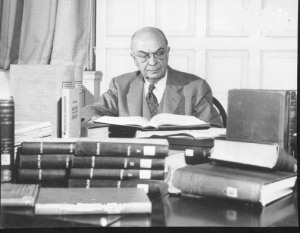 My great-grandfather Luther Weigle [pictured here] was the dean of Yale Divinity School and chair of the translation committee for the original RSV Bible. He incurred the fury of the fundamentalists when he chose to translate the Hebrew word almah in Isaiah 7:14 as “young woman” instead of “virgin.” They actually burned RSV Bibles and sent the ashes to him in the mail. The reason? Isaiah 7:14 is referenced by Matthew’s gospel as an explanation for Jesus’ virgin birth. But Isaiah 7:14 also refers to the “young woman” who was Isaiah’s prophetess wife and definitely not a virgin. In Isaiah 7 and 8, she bore Isaiah two children with prophetic names related to their immediate historical context. Does the doctrine of Christ’s virgin birth depend on translating almah as “virgin” in Isaiah 7:14? Only if Isaiah 7:14 is expected to function as a prooftext for that doctrine, which raises a larger question: to what degree should Old Testament prophecy be used as prooftexts? And if Isaiah 7 is allowed to have less than a perfectly mapped correspondence to the circumstances of Jesus’ birth, then can we apply the same hermeneutical boundaries to the relationship between Isaiah 53 and the circumstances of Jesus’ death on the cross?
My great-grandfather Luther Weigle [pictured here] was the dean of Yale Divinity School and chair of the translation committee for the original RSV Bible. He incurred the fury of the fundamentalists when he chose to translate the Hebrew word almah in Isaiah 7:14 as “young woman” instead of “virgin.” They actually burned RSV Bibles and sent the ashes to him in the mail. The reason? Isaiah 7:14 is referenced by Matthew’s gospel as an explanation for Jesus’ virgin birth. But Isaiah 7:14 also refers to the “young woman” who was Isaiah’s prophetess wife and definitely not a virgin. In Isaiah 7 and 8, she bore Isaiah two children with prophetic names related to their immediate historical context. Does the doctrine of Christ’s virgin birth depend on translating almah as “virgin” in Isaiah 7:14? Only if Isaiah 7:14 is expected to function as a prooftext for that doctrine, which raises a larger question: to what degree should Old Testament prophecy be used as prooftexts? And if Isaiah 7 is allowed to have less than a perfectly mapped correspondence to the circumstances of Jesus’ birth, then can we apply the same hermeneutical boundaries to the relationship between Isaiah 53 and the circumstances of Jesus’ death on the cross?
For champions of the divine wrath satisfaction account of atonement (which I’m distinguishing from penal substitution), Isaiah 53 is one of the most important chapters in the Bible. Without it, they really don’t have any explicit proof-texts to fall on. Romans 5:8-9 may look promising, except that it says we are “saved from the wrath” not by the “blood” of Jesus but by his “life,” which makes it hard to cite it as proof that the cross itself is God’s anger management system.
But Isaiah 53:10 says, “It was the will of The Lord to crush him and cause him to suffer.” The wrath-lovers always pull out Isaiah 53:10 as their trump card in theological debates about the nature of the cross’s atonement. There are other verses from Isaiah 53 that follow the logic of penal substitution, but Isaiah 53:10 is is the only verse that I know of in the Bible that explicitly makes the Father the direct agent of Christ’s suffering on the cross if… Isaiah 53:10 is unequivocally talking about Jesus. Could it be the case that just as Isaiah 7 is a prophecy about Isaiah’s son Immanuel who foreshadowed the birth of Christ, Isaiah 53 is a prophecy about the suffering of the whole people of Israel in exile (or perhaps even some unknown individual whose suffering the prophet witnessed) which foreshadowed the cross of Christ?
If all of Isaiah 7’s prophecy about Immanuel were presumed to map directly onto elements of Jesus’ birth just because Matthew references part of it, then what would we do with verses 16-17:
Before the boy knows enough to reject the wrong and choose the right, the land of the two kings you dread will be laid waste.The Lord will bring on you and on your people and on the house of your father a time unlike any since Ephraim broke away from Judah—he will bring the king of Assyria.
Clearly it’s absurd to apply these verses to Jesus’ childhood. Nobody is speculating which two puppet kings in the region of 1st century Palestine will be laid to waste. And the Assyrian Empire had long since disappeared from the scene after being stomped out by the Babylonians, Persians, Macedonians, and Romans. The boundaries to how tightly we connect the prophecy of Isaiah 7 to Jesus’ birth are set by the way that the New Testament authors use the prophecy. It is only referenced in Matthew 1:22-23 when Gabriel appears to Joseph in a dream:
All this took place to fulfill what the Lord had said through the prophet:“The virgin will conceive and give birth to a son, and they will call him Immanuel”(which means “God with us”).
Jesus doesn’t even get named Immanuel. There is no other reference to this name or this prophecy in the New Testament. But the meaning of the name still colors how we understand his identity. Unlike Isaiah’s son Immanuel, Jesus was quite literally “God with us.” So Isaiah 7 does have a crucial role in Christology but only within the boundaries set by its one New Testament reference.
There are six New Testament references to Isaiah 53, none of which make any mention of verse 10. I have listed the references below with my commentary.
1) Isaiah 53:1: “Who has believed our message and to whom has the arm of the Lord been revealed?”
This verse is cited by John 12:37-38 and Romans 10:16 as a prophetic basis for why Jesus’ people refused to believe in him.
2) Isaiah 53:4: “Surely he has borne our infirmities and carried our diseases.”
Matthew 8:17 says that Jesus’ healing ministry fulfills this verse, which completely changes its meaning from the original context. The second half of the verse says, “Yet we accounted him stricken, struck down by God, and afflicted.” In the original context, the person being talked about is physically ill and presumed to be under God’s wrathful punishment by a pre-scientific people. In the application of the verse, Jesus doesn’t catch diseases like leprosy; he heals leprosy.
3) Isaiah 53:5-6: “But he was wounded for our transgressions, crushed for our iniquities; upon him was the punishment that made us whole, and by his bruises we are healed. All we like sheep have gone astray; we have all turned to our own way, and the Lord has laid on him the iniquity of us all.”
Here’s what 1 Peter 2:24-25 does with these verses: “’He himself bore our sins’ in his body on the cross, so that we might die to sins and live for righteousness; ‘by his wounds you have been healed.’ For ‘you were like sheep going astray,’ but now you have returned to the Shepherd and Overseer of your souls.” Notice what is not there. There is no reference to any cathartic need of God’s being fulfilled by the cross. Jesus bears our sins so that we will “die to sins and live for righteousness.” It is for the sake of our empowerment and transformation.
4) Isaiah 53:7-8: “He was oppressed, and he was afflicted, yet he did not open his mouth; like a lamb that is led to the slaughter, and like a sheep that before its shearers is silent, so he did not open his mouth.By a perversion of justice he was taken away. Who could have imagined his future? For he was cut off from the land of the living, stricken for the transgression of my people.”
The Ethiopian eunuch in Acts 8:32-33 is reading these verses when Philip explains their connection to “the good news about Jesus.” No details are given to us in terms of Philip’s interpretation other than the mere fact that he connects the passage to Jesus.
5) Isaiah 53:9: “They made his grave with the wicked and his tomb with the rich,although he had done no violence, and there was no deceit in his mouth.”
Peter uses this verse in 1 Peter 2:22 in the context of an exhortation to slaves not to give their masters any legitimate reason to beat them. The slaves should be without violence and deceit just like Jesus was.
6) Isaiah 53:12: “Therefore I will allot him a portion with the great, and he shall divide the spoil with the strong; because he poured out himself to death, and was numbered with the transgressors; yet he bore the sin of many, and made intercession for the transgressors.”
Jesus refers back to this verse in Luke 22:37 as an explanation for why he told his disciples to get swords. It’s not because he actually wants them to resist violently; it’s so that they will look like outlaws and he can thus be “numbered with the transgressors.
Conclusion: Out of these six references to Isaiah 53, only one, Peter 2:24-25, uses it directly to talk about atonement (though I suppose you could argue that 1 Peter 2:22 uses Jesus’ cross as a moral exemplar but it’s not really atonement per se). What Jesus’ atonement does in 1 Peter 2:24-25 is to empower sinners to “die to sins and live to righteousness,” which has nothing to do with satisfying God’s wrath.
Furthermore, some verses in Isaiah 53 do not map well at all onto Jesus’ story. He didn’t carry diseases in his body that made people looking at him think he was stricken by God (v. 4). That’s why Matthew 8:17 has to completely change the meaning of that verse in its reference. Neither is it really accurate to say about Jesus that “he had no form or majesty that we should look at him, nothing in his appearance that we should desire him” (v. 2). People didn’t blow Jesus off. He drew crowds. Everywhere. Everyone wanted to be with him. He had to sit on Simon Peter’s boat to teach that he wouldn’t get crushed by them. So not everything in Isaiah 53 can be taken as a face value description of Jesus.
Clearly, Isaiah 53 has a stronger connection to Jesus than Isaiah 7. But none of the New Testament authors claim that the purpose of Jesus’ cross was to provide the Father with someone to crush and make suffer. That’s why I don’t think Isaiah 53:10 can perform the tremendously heavy lifting that the wrath-satisfaction enthusiasts require of it.
Furthermore even if Isaiah 53:10 is applied to the cross, to say, “It was the will of the Lord to crush him and cause him to suffer,” doesn’t make the Father Jesus’ wrathful executioner any more than the role of the Israelite exile in God’s plan means that God incarnated Himself as the Babylonian emperor Nebuchadnezzar and personally led the forces who burned His beloved Jerusalem to the ground.
Jesus’ suffering on the cross was indeed part of God’s will, but in order to rescue humanity, not because God had any need for emotional catharsis that required it. The cross is certainly a form of punishment. But it’s important that the punishment was administered by the Roman state, and that it was an unjust punishment eagerly endorsed by a crowd of Jesus’ own people. If Jesus’ cross is merely an abstract mathematical tool for accomplishing God’s justice, that minimizes the injustice and betrayal that compelled 3000 Jews to get baptized in his name when they were cut to the heart in Acts 2:37 after Peter said, “God has made him both savior and Lord, this Jesus whom you crucified” (v. 36).
Insofar as we speak of the cross juridically, which is one of the many metaphors with which we can speak of it, its relevance is to provide humanity with the safe means of escaping the ancient curse of Adam’s fall, the delusion that we are able and are supposed to justify ourselves (Romans 3:20). The cross makes it possible for us to accept God’s unilateral amnesty by proclaiming us guilty first since we are part of the same eternal mass of humanity that murdered the Word of God made flesh. We wouldn’t have done any differently if we were physically part of the first century crowd that yelled “Crucify him!” and we commit sins every day that participate in Christ’s eternal crucifixion.
Peter’s words in Acts 2:36 apply to us even today because the cross is all of humanity’s crime against God, which God not only overrules through Jesus’ resurrection but paradoxically reappropriates to become our jailbreak from slavery to the eternal accuser Satan. To say that Jesus was “crushed” (Isaiah 53:10) really doesn’t fit Jesus’ death any more than the ugliness or disease (Isaiah 53:2 and 4) fits Jesus’ life. Even so, it was of course part of God’s plan for Jesus to get crucified. But it wasn’t God who crucified Him. We did. And God turned the ugliness of our sin into the beauty of His redemption.











